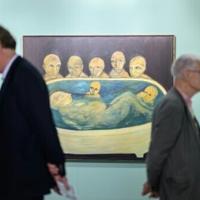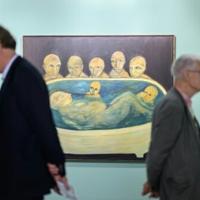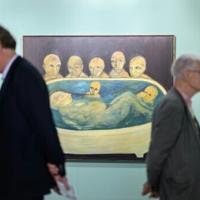Art Market
Arun Kakar
Jan 17, 2025 6:24PM
Khairulddin Wahab, installation view of The Lands Below the Winds, 2024, presented by Cuturi Gallery at ART SG 2025. Courtesy of ART SG 2025.
It’s known colloquially as the “Switzerland of Asia,” so has Singapore finally got an Art Basel equivalent of its own? That was the question on the minds of many art world watchers when ART SG launched in 2023. And as ART SG 2025, the third edition of the fair, opened on Thursday, the attitude among those in attendance remained defiantly bullish.
“People are really taking Singapore very seriously as a market hub,” the fair’s co-founder Magnus Renfrew told Artsy. “Clearly it’s early days, but I think that people are getting a sense that there’s optimism, or at least, certainly a noticeable absence of pessimism.”
Interior view of ART SG 2025. Courtesy of ART SG 2025.
Advertisement
ART SG has quickly become the linchpin of Singapore Art Week. This older weeklong event first started in 2013 and features a packed itinerary of museum and gallery events, as well as the smaller, more locally oriented fair S.E.A. Focus. The city’s growing prominence as an arts hub has been a theme of recent years: Galleries such as Woaw and Whitestone have opened branches, encouraged by the resilience of the city-state’s longstanding institutions, such as the Singapore Art Museum and National Arts Council.
Much of the optimism surrounding the Singaporean market can be attributed to the recent growth in wealth in the city-state. Family offices—investment vehicles for very wealthy families—were up by 43% in 2024 compared to the previous year, and Singapore’s wealth management sector has doubled since 2018, with some 80% of assets originating outside Singapore. Notably, wealthy collectors in Singapore have a buoyant attitude towards buying: According to last year’s Art Basel and UBS Survey of Global Collecting, 97% of Singapore high-net-worth collectors were the “most optimistic” about the global art market.
Installation view of Sundaram Tagore’s booth at ART SG 2025. Courtesy of ART SG 2025.
This year’s edition of ART SG comprises 105 galleries and is split into three sections over two floors: On the first floor is Focus, dedicated to galleries presenting solo, duo, or specially curated programs; and Futures, which features galleries in business for 10 years or less. The main Galleries section of 56 exhibitors resides on the lower floor. Notably, this year’s edition of ART SG is its smallest yet. Last year’s fair featured 116 galleries, and more than 150 attended its inaugural edition. Several of the heavyweight names that participated in the fair’s debut event, such as David Zwirner and Pace Gallery, have not returned (but mega-galleries including Gagosian, White Cube, and Thaddaeus Ropac are present for a third consecutive time).
Renfrew puts the reduced number of exhibitors down to “adverse conditions, geopolitically, geo-economically, that everywhere in the world has been facing.” He noted the “encouraging” fact that a number of galleries that featured in the first edition of the fair, but not the second, had returned this year. “We are keen to grow the fair as the market grows, and the most important thing for us is to maintain quality and to make sure that the galleries that are here are having a successful time,” he added.
A “bigger isn’t always better” attitude was noticeable among galleries, too. “It’s a difficult time in the art market right now, but I think some of these newer, smaller fairs offer a quality of experience that is very different to some of the really big established fairs, which, frankly, can become overwhelming,” said Jacob Twyford, senior board director at London’s Waddington Custot. The gallery is showing a broad selection of works by a gamut of leading international names including Kenia Almaraz Murillo, March Avery, Peter Blake, Fernando Botero, Ian Davenport, Robert Indiana, and Sean Scully. Bringing a broad range of works—and at a corresponding range of price points—reflects the fair’s varied audience, Twyford noted: “People are maybe more open to being amazed or seduced by something,” he said.
This composition of visitors was noticed by several galleries across the fair, where everything from blue-chip to bleeding-edge emerging works were present, often in the same booth. “The fair attracts a different level of collector,” noted Frej Forsblom, founder of Makasiini Contemporary, which has been attending the fair since its inception. “It’s not only for high-end buyers, but also new beginners.” The gallery, based in the Finnish city of Turku, has also brought a mixed booth of works by artists in its program such as Nir Hod, Jacob Hashimoto, and Yuichiro Sato. Prices at the booth range from $22,000 to $80,000.
Installation view of Makasiini Contemporary’s booth at ART SG 2025. Courtesy of Makasiini Contemporary.
Singapore’s regional pull was another theme highlighted by galleries across the fair. Making its debut at the fair this year is London gallery rosenfeld, which is targeting the “different price points and kinds of collector bases,” said Josephine May Bailey, a director at the gallery. The three-artist booth includes paintings by Riccardo Guarneri, Araminta Blue, and Enrique Brinkmann, priced between $9,000 and $20,000. “We’re already investing our time and energy into this side of the world and I think Singapore has a reputation of being somewhere with a lot of business capital,” she added. Fellow debutante Inloco Gallery from Dubai echoed this view, with representative Nadya Kovaleva noting the region as a “new sector of development” for the gallery. Its booth, a solo presentation of works by Italian artist Filippo Minelli, features a VR headset where visitors can navigate the artist’s “digital idealized city,” according to the gallery’s press materials.
International exchange is also central to the fair, which draws galleries from 30 countries and territories. “We’ve really found that as we have learned more about the collecting practices in the region, and engage with multiple audiences, collectors, and institutions, our program has found great traction,” said Anthony Dawson, a director at Goodman Gallery. The Johannesburg-founded gallery is presenting a mixed booth of major artists in its program, such as William Kentridge and Kapwani Kiwanga, who most recently represented Canada at last year’s Venice Biennale. “It’s just wonderful to be able to showcase a cross-section of our program and see that it holds resonance with people globally,” Dawson added.
But the fair maintains a strong regional focus: Some 32 participants also have branches in Southeast Asia, with 21 running a space in Singapore—including Tang Contemporary Art, which opened an outpost last year. “We are always looking for new opportunities, and we have a lot of clients, especially [from] Indonesia, Malaysia, Philippines, coming to Singapore for the fair,” said Sue Oh, art director at the gallery. The works at its booth are by artists from the region, from Thai painter Kitti Narod to Chinese artist Leng Guangmin.
Another country prominently represented at the fair is India. “Singapore has always had a very strong Indian diaspora, and that’s also the case with Southeast Asia in general,” said Priya Midgal, vice president of art advisory at Delhi powerhouse DAG. “We have very strong collectors here.” The gallery is showing works by Bombay Progressive Group artists Francis Newton Souza and Maqbool Fida Husain, as well as Indian women artists Shobha Broota and Madhvi Parekh. “It’s important to understand that we would like to educate our client base…about various Indian artists who are also not just the top names,” Midgal added.
As the fair’s VIP day got underway, it was clear that the Singapore fair was pulling in a diverse audience, who continued to filter into the venue throughout the day. And as the afternoon preview began to bleed into the evening vernissage, a number of significant sales reported by galleries affirmed that collectors were willing to spend, too. Leading the ticket during the day was a Pablo Picasso work on paper, Buste d’Homme à la pipe (1969), which sold at Cardi Gallery’s booth for $1.2 million.
Other significant sales included a Tunji Adeniyi-Jones work, Celestial Gathering (2024), which sold for $350,000 at White Cube, and Teresita Fernández’s Stella Maris(Net) 4 (2024), which was sold at Lehmann Maupin’s booth for a price in the range of $120,000–$125,000 to a “prominent” Singaporean collector. Other six-figure sales reported by galleries across the fair included Lee Bae’s Issu de feu K-20 (2003) for $180,000 at Johyun Gallery’s booth and Roberto Matta’s Is thou so desired? (1957) for $150,000 at Galerie Gmurzynska. Galleries also reported a number of sales at five-figure price points, including a pair of Tuan Vu works at Kristin Hjellegjerde Gallery for $20,000 apiece.
While the full picture of sales from the fair will become clearer as it continues over the weekend, a long-term view was pervasive across galleries at the fair. “We look at things in a much longer time span,” said Yelin Que, an associate director at Hong Kong, London, and New York gallery Alisan Fine Arts, which is presenting a wide-ranging booth of more than 30 works from across its program. “We [have an] expansion outlook, so of course it is only natural for us to look at new areas, and that’s how we started.”
Indeed, ART SG is in its nascency, and international art capitals don’t just appear overnight. But as many at the fair are keen to emphasize, the broad direction of travel remains a positive one. The hope is that there is enough traction on the journey. “It’s still very early days for the development of the market, but I think in three short years [we’ve] seen how far things have come in terms of the institutions that are popping up around Southeast Asia and have this sort of increased interest from collectors about starting their collecting journeys,” said Renfrew. “It really bodes well for the next few years.”
Arun Kakar
Arun Kakar is Artsy’s Art Market Editor.
This post was originally published on this site be sure to check out more of their content



